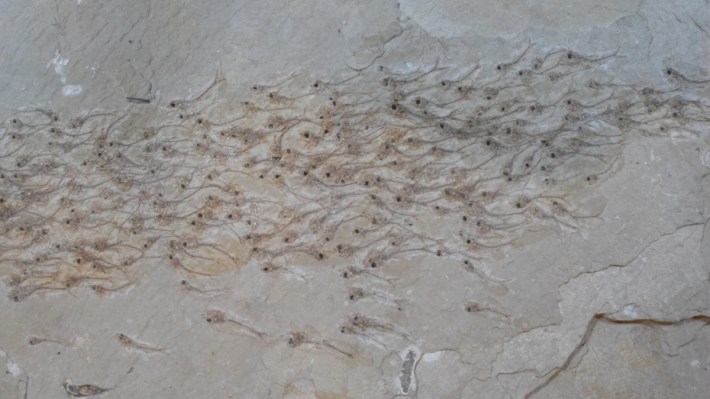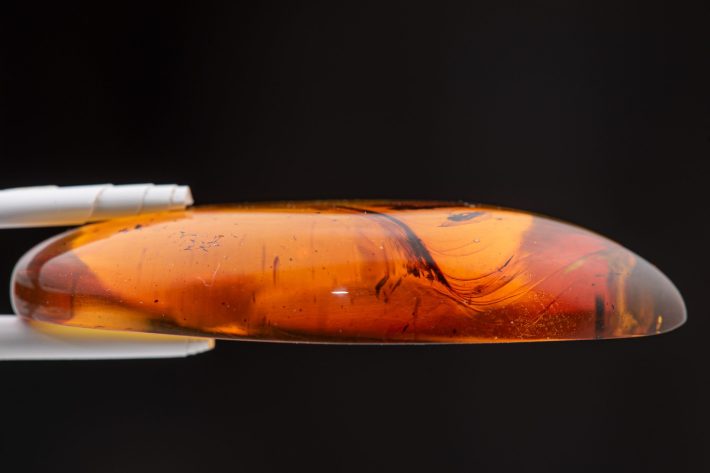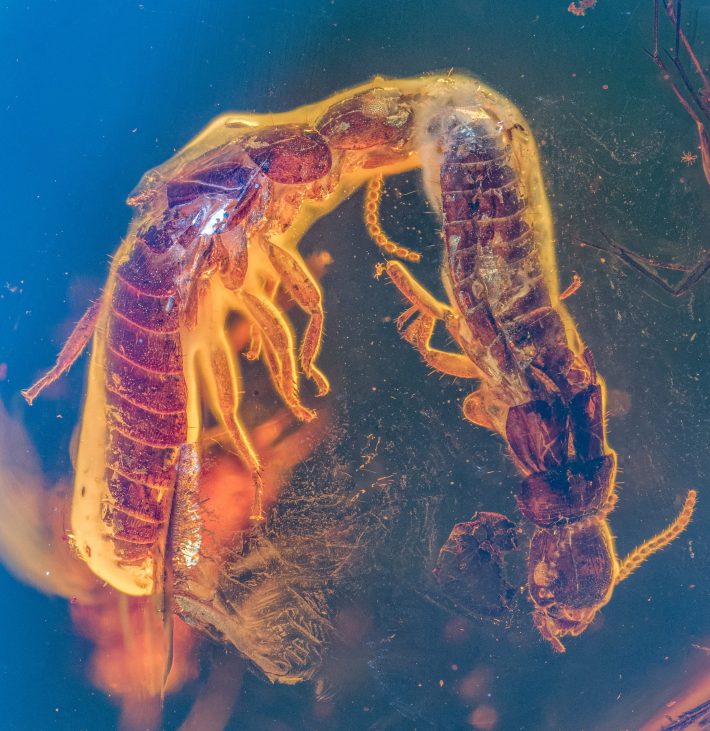When Nobuaki Mizumoto, a biologist at Auburn University, first saw two figures trapped inside the amber teardrop, it was as if the universe had conspired to deliver him the perfect fossil. It wasn't that the fossil held both a male and a female termite, but rather that the termites were touching, with the female's mouthparts grasping the tip of the male's abdomen. Mizumoto recognized this positioning as a a courtship ritual common among modern species of termites. Mizumoto researches the evolution of collective behavior, or when multiple animals coordinate their actions, in termites. So this fossil was electrifying—preserving not just the termites but also potentially their behavior. He had been searching for fossilized evidence of behavior, and here it was—preserving a practice he's observed in real life in a similar species. "I mean, this is an exact right thing for me," he said. "This is a really good fossil."
Mizumoto's colleague Aleš Buček, the head of the Laboratory of Insect Symbiosis at the Czech Academy of Sciences, had found the Baltic amber fossil on an online shop for collectors. He immediately reached out to Mizumoto, familiar with the biologist's research gleaning behavioral insights from fossils. With amber in hand, the researchers collaborated on a new paper that not only describes the fossil, but also experimentally models the preservation process that might have led to the termite pair's entrapment. The researchers recently published their work in a paper in the Proceedings of the National Academy of Sciences.
Mizumoto, who grew up in the countryside of Fukui Prefecture in Japan, first became interested in researching collective behavior in animals while wandering around the Fukui Prefectural Dinosaur Museum, which he visited often as a child. In 2015, after seeing Jurassic World, Mizumoto returned to the museum with his wife when he noticed a striking fossil—not of dinosaurs, but of 259 extinct fish of the species Erismatopterus levatus, each under an inch long. Each individual fish on the slab of limestone is pointing in the same direction, and most are densely clustered with a few stragglers on the outside. In other words, it looks uncannily like a school of fish.

Smitten, Mizumoto published a paper on the fossil in 2019, arguing that the fossilized shoal is evidence that fish have been schooling for at least 50 million years. The researchers extrapolated the behavioral dynamics of a modern fish school from the fossil, such as how neighboring fish move away from each other and distant fish move closer to each other. But some scientists were wary of drawing such conclusions from a fossil, according to The New York Times. Some critics noted that the school would have had to be buried instantaneously for the school to be preserved as in life. Although Mizumoto suggested dead fish would be more scattered across the slab, he acknowledged he could not exclude this possibility.
"If you look at the fossil, you feel like this is definitely a fish school," Mizumoto said. "But, I mean, we have no idea how that type of process can be created in the first place." The only way to be sure, Mizumoto suspected, would be to test the fossilization process in real life. But how? Dump a heap of sand on a school of fish? His research didn't have anything to do with fish. "I had really no opportunities to compare the pattern in the fossil with a real animal and try to make it fossilize," he said. When Mizumoto saw the termite fossil, he knew this was the perfect opportunity to test the behaviors he thought he was observing in the fossil. "Now it's time. I can compare that fossil behavior with real insects, because I'm working with termites," he said.

When an organism dies, there is a chance a part of their body or an impression they leave will be preserved for some distant future. But any traces of their behavior are almost always lost to time, disturbed by scavengers, decomposition, or even the geological process of fossilization. "Organisms always move when they are being trapped," Sergio Álvarez-Parra, a paleontologist at Nanjing Institute of Geology and Palaeontology at the Chinese Academy of Sciences, who was not involved with the paper, wrote in a email. For example, being trapped in sticky tree resin that will eventually fossilize into amber is an unpleasant experience, often resulting in the loss of body parts, the evacuation of one's bowels, and other stress responses, such as egg-laying.
So scientists must be careful when drawing these conclusions. "A behavior never fossilizes," Álvarez-Parra added. "A behavior in a fossil might be only inferred." But taphonomy, the study of the process of fossilization, helps researchers understand how how this process might have interfered with the animal's preservation, and, by extension, how much researchers can infer about behavior from a fossil.
Mizumoto and colleagues argue that amber can offer a uniquely detailed snapshot into an animal's lifestyle, sometimes capturing multiple individuals or individuals in action. In some instances, this preservation can be remarkable and may offer an uncanny tableau of ancient behavior, such as the drop of Baltic amber containing two actively mating fungus moths or the shard of Mexican amber preserving an army ant holding a termite worker between its mandibles, alongside a bitten termite. "Although it is risky to assume behaviors for fossil specimens, amber can give us information in a fine detail," Álvarez-Parra, said.
To simulate the fossilization process that entombed the mating termites, the researchers introduced mating pairs of the Formosan termite Coptotermes formosanus onto sticky insect traps, which other researchers have used to model gluey tree resin. The Formosan termite, like other termites, engage in the courtship behavior called "tandem run" in which a male and female venture out together, with one leading and the other following. In modern termites, termites tandem run in a straight line. But the fossilized termites appeared side-to-side, which would be an unusual interpretation of the tandem run.

When the mating pairs of termites dutifully scurried across the sticky traps, the leading termite would get stuck first but the follower would forge ahead, resulting in both becoming immobilized. In some scenarios, the mating pair wound up side-by-side after struggling to escape the sticky trap, recalling the position of the fossilized termites. "I think in reality it actually takes some time for them to be completely encapsulated by the resin," Mizumoto said.
Resin, however, doesn't just come in one viscosity. Even one species of tree can produce different amounts and types of resin depending on the conditions of the environment and climate. "The capacity of resins for trapping organisms depends on the fluidity, the stickiness, and the hardening time," Álvarez-Parra said. The fossilized termites were trapped in Baltic amber, meaning the resin likely came from conifers. "But, in any case, the tree species producing the resin is extinct today, so we cannot know exactly the characteristics of the resin," he added.
Mizumoto acknowledges that resin, and stickiness, can be highly variable. "But what we tried to show is that it's possible," he said. And just one example can be a strong argument. "I agree with the authors that it is plausible that this fossil genus could have showed a similar mating behavior," Álvarez-Parra said. He added that papers that explore "behaviors of extinct fauna are always interesting and helpful [to] better understand the life in the past."
Mizumoto hasn't yet discovered another rare fossil with insight to share about ancient collective animal behavior. Perhaps the third will fall into his lap as serendipitously as the first. But until then, termites around the world can rejoice that they have finally been represented in the canon of doomed and sappy love stories.
"like this" - Google News
March 27, 2024 at 04:24AM
https://ift.tt/dqOEZKL
If Romeo And Juliet Were Ancient Termites They Wood Look Like This - Defector
"like this" - Google News
https://ift.tt/UkW3bAM
Shoes Man Tutorial
Pos News Update
Meme Update
Korean Entertainment News
Japan News Update
No comments:
Post a Comment